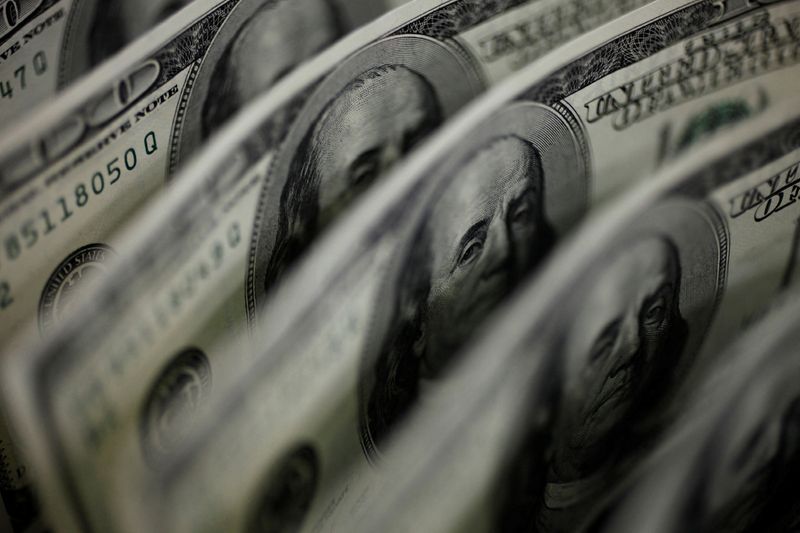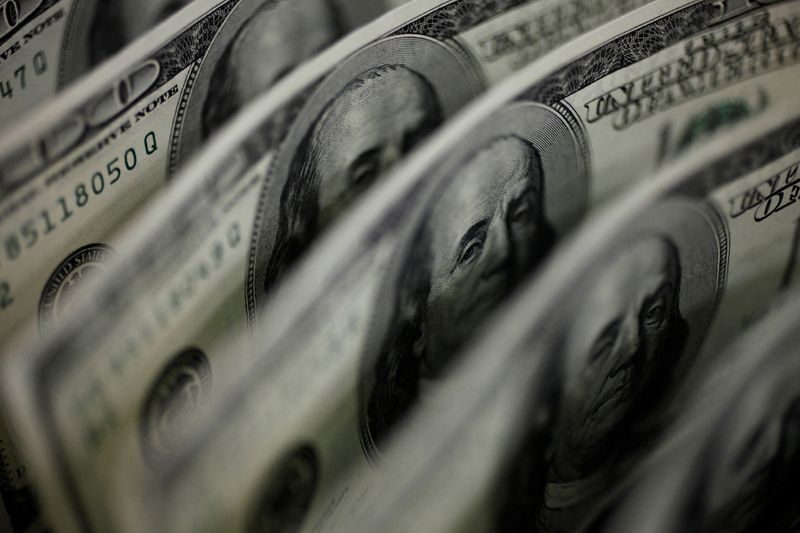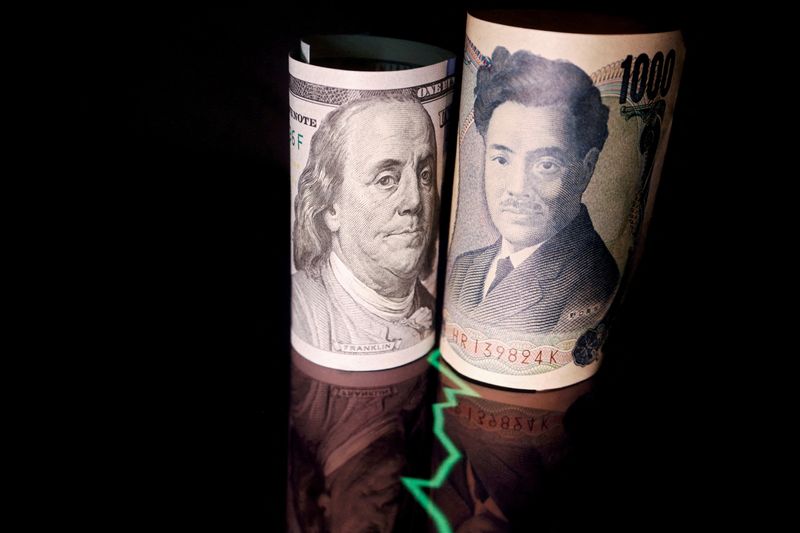Forex
Explainer-What would Japanese intervention to boost a weak yen look like?

By Leika Kihara
TOKYO (Reuters) -Japanese authorities are facing renewed pressure to combat a sustained depreciation in the yen, as traders drive down the currency on expectations that any further interest rate hikes by the central bank will be slow in forthcoming.
Below are details on how yen-buying intervention works:
LAST CONFIRMED YEN-BUYING INTERVENTION?
Japan bought yen in September 2022, its first foray in the market to boost its currency since 1998, after a Bank of Japan (BOJ) decision to maintain its ultra-loose monetary policy drove the yen as low as 145 per dollar. It intervened again in October after the yen plunged to a 32-year low of 151.94.
WHY STEP IN?
Yen-buying intervention is rare. Far more often the Ministry of Finance has sold yen to prevent its rise from hurting the export-reliant economy by making Japanese goods less competitive overseas.
But yen weakness is now seen as problematic, with Japanese firms having shifted production overseas and the economy heavily reliant on imports for goods ranging from fuel and raw materials to machinery parts.
WHAT HAPPENS FIRST?
When Japanese authorities escalate their verbal warnings to say they “stand ready to act decisively” against speculative moves, that is a sign intervention may be imminent.
Rate checking by the BOJ – when central bank officials call dealers and ask for buying or selling rates for the yen – is seen by traders as a possible precursor to intervention.
WHAT HAPPENED SO FAR?
Finance Minister Shunichi Suzuki told reporters on March 27 that authorities could take “decisive steps” against yen weakness – language he hasn’t used since the 2022 intervention.
remove ads
.
Hours later, Japanese authorities held an emergency meeting to discuss the weak yen. The meeting is usually held as a symbolic gesture to markets that authorities are concerned about rapid currency moves.
After the warnings failed to arrest the yen’s fall, South Korea and Japan won acknowledgement from the United States over their “serious concerns” about their currencies’ declines in a trilateral meeting held in Washington last week.
The market impact of the agreement did not last long. The dollar continued its ascent and notched a 34-year high of 155.74 yen on Thursday, driving past the 155 level seen as authorities’ line in the sand for intervention.
NEXT LINE IN THE SAND?
Authorities say they look at the speed of yen falls, rather than levels, and whether the moves are driven by speculators, to determine whether to step into the currency market.
While the dollar has moved above the psychologically important 155 level, the recent rise has been gradual and driven mostly by U.S.-Japanese interest rate differentials. That may make it hard for Japan to argue that recent yen falls are out of line with fundamentals and warrant intervention.
Some market players bet Japanese authorities’ next line in the sand could be 160. Ruling party executive Takao Ochi told Reuters the yen’s slide towards 160 or 170 to the dollar could prod policymakers to act.
WHAT’S THE TRIGGER?
The decision is highly political. When public anger over the weak yen and a subsequent rise in the cost of living is high, that puts pressure on the administration to respond. This was the case when Tokyo intervened in 2022.
remove ads
.
Prime Minister Fumio Kishida may feel the need to prevent further yen falls from pushing up the cost of living with his approval ratings faltering ahead of a ruling party leadership race in September.
But the decision would not be easy. Intervention is costly and could easily fail, given that even a large burst of yen buying would pale next to the $7.5 trillion that change hands daily in the foreign exchange market.
HOW WOULD IT WORK?
When Japan intervenes to stem yen rises, the Ministry of Finance issues short-term bills, raising yen it then sells to weaken the Japanese currency.
To support the yen, however, the authorities must tap Japan’s foreign reserves for dollars to sell for yen.
In either case, the finance minister issues the order to intervene and the BOJ executes the order as the ministry’s agent.
CHALLENGES?
Japanese authorities consider it important to seek the support of Group of Seven partners, notably the United States if the intervention involves the dollar.
Washington gave tacit approval when Japan intervened in 2022, reflecting recent close bilateral relations.
Finance Minister Suzuki said last week’s meeting with his U.S. and South Korean counterparts laid the groundwork to act against excessive yen moves, a sign Tokyo saw the meeting as informal consent by Washington to intervene as needed.
U.S. Treasury Secretary Janet Yellen said currency interventions should occur only in “very rare and exceptional circumstances,” when markets are disorderly with excessive volatility. She declined to comment on the yen’s value.
A looming U.S. presidential election may complicate Japan’s decision on whether and when to intervene.
remove ads
.
In a social media post on Tuesday, Republican presidential candidate Donald Trump decried the yen’s historic slide against the dollar, calling it a “total disaster” for the United States.
There is no guarantee intervention will effectively shift the weak-yen tide, which is driven largely by expectations of prolonged low interest rates in Japan. BOJ Governor Kazuo Ueda has dropped hints of another rate hike but stressed that the bank will tread cautiously given Japan’s fragile economy.
Forex
Dollar steadies as traders eye Federal Rate path following soft U.S. jobs data

Investing.com — The U.S. dollar steadied on Monday after slumping in the prior week on weaker-than-anticipated nonfarm payrolls data, which led traders to push up the timeline for potential Federal Reserve interest rate cuts this year.
At 04:31 ET (08:31 GMT), the U.S. , which tracks the greenback against a basket of six other currencies, traded 0.04% higher at 105.07.
It had fallen last week to a more than three-week low, a decline fueled by wagers that the Fed may now choose to slash rates from more than two-decade highs as soon as September. Markets were previously betting that the central bank would roll out an initial 25-basis point reduction in November.
The soft payrolls data also put upcoming addresses by a string of key Fed officials this week squarely in focus. On Monday, New York Fed President John Williams and Richmond Fed President Thomas Barkin are both set to speak, followed by Minneapolis Fed President Neel Kashkari a day later. Chicago Fed President Austan Goolsbee and Fed Governor Michelle will make appearances later this week as well.
The euro exchanged hands 0.1% higher at $1.0769. The European Central Bank is widely tipped to roll out its own rate cut in June, although it remains uncertain what will happen with monetary policy after the meeting.
Meanwhile, the British pound traded 0.2% higher at $1.2573. Data last week showed that the U.K.’s key services sector remains in a healthy state, possibly granting the Bank of England more room to delay rate reductions.
remove ads
.
Broader Asian currencies retreated after recently gaining some ground against the dollar. But the prospect of U.S. borrowing costs remaining elevated in the near-term kept most regional currencies trading negative for the year.
The Japanese yen’s pair rose 0.6% on Monday, although trading volumes in the pair were held back by a market holiday in Japan, while the Chinese yuan’s pair fell 0.4%.
The Singapore dollar’s pair advanced 0.1%, while the Indian rupee’s pair edged up 0.1%.
Elsewhere, the Australian dollar’s pair climbed 0.3%, coming close to two-month highs as traders positioned for a Reserve Bank of Australia meeting on Tuesday. While the RBA is expected to keep rates unchanged, it is also expected to strike a hawkish chord after a stronger-than-expected inflation reading for the first quarter.
Forex
Asia FX dips as dollar steadies from payrolls plunge; yen reverses course

Investing.com– Most Asian currencies weakened on Monday as the dollar steadied from a tumble on Friday after weaker-than-expected payrolls data saw markets ramp up bets on interest rate cuts by the Federal Reserve.
The Japanese yen was the worst performer in Asia, reversing course after apparent government intervention last week saw the currency rebound from 34-year lows.
Most regional currencies were also sitting on strong gains from Friday, following the payrolls reading and the corresponding drop in the dollar. But the greenback found its footing on Monday.
Japanese yen reverses some gains, USDJPY rises
The Japanese yen’s pair rose 0.6% on Monday, although trading volumes in the pair were held back by a market holiday in Japan.
The pair, which is inversely related to strength in the yen, had plummeted from a 34-year high of over 160 yen last week amid signs of repeated government intervention in currency markets.
But given that the underlying factors behind the yen’s weakness- chiefly a large gap between U.S. and local rates- remain in play, bets against the yen persisted.
The USDJPY pair was now close to breaking above 154, with traders also doubting just how much capacity Tokyo had to keep intervening in markets.
Australian dollar strong, AUDUSD up before hawkish RBA
The Australian dollar’s pair rose 0.1% on Monday, coming close to two-month highs as traders positioned for a on Tuesday.
While the RBA is expected to keep rates unchanged, it is also expected to strike a hawkish chord after a stronger-than-expected inflation reading for the first quarter.
remove ads
.
Sticky inflation gives the RBA more impetus to keep rates high for longer, with some analysts suggesting the bank could even hike rates further.
Dollar steadies after payrolls-driven plunge, rate cuts in focus
The and both rose 0.1% in Asian trade after tumbling 0.8% last week. Losses in the greenback came as data read weaker than expected for April.
The data furthered bets that a cooling labor market will give the Federal Reserve more impetus to begin cutting interest rates. The showed traders ramping up their bets for a 25 basis point cut in September.
The soft payrolls data also put upcoming addresses by a string of key Fed officials this week squarely in focus.
Broader Asian currencies retreated after gaining some ground against the dollar last week. But the prospect of U.S. interest rates remaining high in the near-term kept most regional currencies trading negative for the year.
The Chinese yuan’s pair fell 0.4% on Monday in catch-up trade, as onshore yuan trading resumed after a long weekend.
The Singapore dollar’s pair rose 0.2%, while the Indian rupee’s pair rose 0.1% and back towards record highs.
Forex
Dollar drops as employers add fewer jobs than expected in April

By Karen Brettell
NEW YORK (Reuters) – The dollar fell to a three-week low against the yen on Friday after data showed U.S. jobs growth slowed more than expected in April and annual wage gains cooled, boosting bets that the Federal Reserve will cut rates twice this year.
Employers added 175,000 jobs last month, below economists’ expectations for a 243,000 increase. Wages increased 3.9% in the 12 months through April, below expectations for a 4.0% gain after rising 4.1% in March.
The unemployment rate rose to 3.9% from 3.8%, remaining below 4% for the 27th straight month.
“The data’s soft across the board from the Fed’s perspective,” said Jason Pride, chief of investment strategy and research at Glenmede in Philadelphia.
Fed funds futures traders raised bets that the Fed would cut rates twice this year, with 47 basis points of easing priced in, up from 42 basis points before the data.
“The market at this point is so hoping that the Fed can cut rates this year and did not want one of the hot numbers coming in. Today’s report certainly offers them a cooler read of the labor landscape,” said Quincy Krosby, chief global strategist at LPL Financial (NASDAQ:) in Charlotte.
Still, the report itself is unlikely to sway Fed policy unless the trend continues.
“An unemployment rate of 3.9% is not something disastrous. This indicates an economy that is not declining dramatically, but it definitely indicates a looser labor market,” said Pride. “It gives the Fed some hope, but it does not establish the trend for them.”
remove ads
.
The Fed said after its two-day meeting on Wednesday that sticky inflation meant that it would take longer to cut rates.
Inflation should continue to decline even as the U.S. central bank holds its benchmark interest rate at current levels, Fed Governor Michelle Bowman said on Friday while reiterating her willingness to raise the policy rate if progress peters out or reverses.
The jobs report showed “solid” growth that slowed to a point that could make Fed officials more confident the economy is not overheating, Chicago Fed President Austan Goolsbee said on Friday.
Other data on Friday showed the U.S. services sector contracted in March, while a measure of prices paid by businesses for inputs jumped, a worrisome sign for the inflation outlook.
The was last down 0.27% at 105.03 after reaching 104.52, the lowest since April 10. The euro gained 0.39% to $1.0766.
The greenback weakened 0.48% to 152.9 Japanese yen, reaching as low as 151.86, the weakest since April 10.
The yen surged in light trading late on Wednesday and on Monday, which traders and analysts attributed to intervention by Japanese authorities.
Japanese Finance Minister Shunichi Suzuki said on Friday that authorities may need to smooth any excessive yen moves that hurt households and companies.
The yen is on track for its best weekly percentage gain against the greenback since November 2022, after Japanese authorities also intervened in October 2022 to shore up the currency.
The yen reached a 34-year low of 160.245 on Monday as it suffers from a wide interest rate differential with the dollar.
remove ads
.
In cryptocurrencies, bitcoin gained 5.30% to $61,828.

 Forex2 years ago
Forex2 years agoForex Today: the dollar is gaining strength amid gloomy sentiment at the start of the Fed’s week

 Forex2 years ago
Forex2 years agoHow is the Australian dollar doing today?

 Forex1 year ago
Forex1 year agoUnbiased review of Pocket Option broker

 Forex2 years ago
Forex2 years agoDollar to pound sterling exchange rate today: Pound plummeted to its lowest since 1985

 Cryptocurrency2 years ago
Cryptocurrency2 years agoWhat happened in the crypto market – current events today

 World2 years ago
World2 years agoWhy are modern video games an art form?

 Stock Markets2 years ago
Stock Markets2 years agoMorgan Stanley: bear market rally to continue

 Economy2 years ago
Economy2 years agoCrude oil tankers double in price due to EU anti-Russian sanctions

































